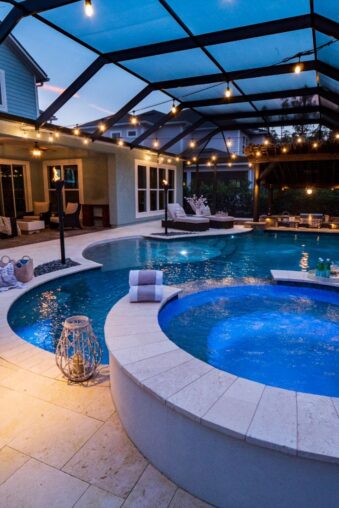
When thunder rumbles and lightning strikes, the first instinct is to seek shelter. While swimming outdoors during a thunderstorm is undeniably dangerous, the safety of swimming in an indoor pool during such weather might not be as clear-cut as one would assume.
Contrary to common perception, swimming in an indoor pool during a thunderstorm isn’t entirely safe. In this comprehensive guide, we will explore the hidden risks and safety measures associated with indoor pool swimming during a thunderstorm, shedding light on why caution should still prevail—even in a sheltered environment.
The Perceived Safety of Indoor Pools

Indoor swimming pools, shielded from the elements, often offer a greater sense of security during inclement weather. However, the protection they provide isn’t absolute.
To understand why swimming during a thunderstorm in an indoor pool remains a potential hazard, we need to delve into the risks associated with lightning, electrical equipment failures, and structural vulnerabilities.
Risk 1: Lightning Strikes and Electrocution
Lightning is a capricious force of nature that doesn’t discriminate based on your location. Although being indoors does reduce the risk, it doesn’t eliminate it entirely.
Lightning’s path of least resistance to the ground can involve the electrical and plumbing systems of a building, both of which are typically highly conductive due to their metallic components.
Imagine a scenario where lightning strikes the building or a nearby structure. The resulting electric charge can travel through these systems and potentially reach the pool area. The water in the pool, containing impurities and inherent ions, can act as a conductor, transmitting the electric charge to anyone in the water.
While the statistical probability of this happening is low, the consequences, if it were to occur, could be life-threatening.
Risk 2: Failure of Electrical Equipment
Swimming pools rely heavily on electrical equipment to maintain a safe and comfortable environment. These systems, including lighting, water filtration, and cleaning, are vulnerable during a thunderstorm. Power surges or outages caused by lightning can overload and damage this equipment.
Consider the impact of a sudden power surge on the pool’s lighting system. The result could be an immediate plunge into darkness, posing a risk to swimmers.
Furthermore, the pool’s water filtration and cleaning systems, vital for maintaining water hygiene, could be compromised during a storm. While this may not pose an immediate threat, prolonged exposure to inadequately maintained water could lead to health issues.
Additionally, disruptions in heating systems could cause rapid fluctuations in water temperature, potentially resulting in discomfort and physiological shock.
Risk 3: Damage to the Building Structure

Severe thunderstorms bring with them high winds, lightning strikes, and even hail, all of which can inflict damage on buildings. The structure that houses an indoor pool is no exception.
Roofing materials, windows, and load-bearing walls are all vulnerable to damage during a storm. In extreme cases, this could lead to structural collapse or leaks.
Even less severe damage, such as broken windows or compromised walls, can allow elements of the storm inside, creating wet, slippery surfaces that increase the risk of accidents.
These three risks highlight why swimming in an indoor pool during a thunderstorm isn’t as safe as it might initially seem. In the following sections, we will answer frequently asked questions about what to do in such situations, public pool protocols, and the importance of personal responsibility for safety.
Frequently Asked Questions
What should you do if you’re in an indoor pool when a thunderstorm starts?
If you find yourself in an indoor pool during a thunderstorm, the best course of action is to exit the pool immediately and move to a safe, enclosed area away from windows, doors, and any electrical equipment. Avoid touching any electrical devices, including corded phones.
Cordless phones and mobile devices are safe to use during a storm. Furthermore, steer clear of sinks, baths, and faucets, as they are connected to plumbing, which can conduct electricity.
In public facilities, it’s essential to follow the instructions of the staff or the facility’s emergency protocols and cooperate calmly to ensure everyone’s safety.
What is the protocol of most public indoor pools during a thunderstorm?
While specific protocols may vary, most public indoor pools adhere to safety guidelines that include clearing the pool and surrounding wet areas at the first sign of a thunderstorm.
The “30-minute rule” is often applied, which means the pool remains clear for at least 30 minutes after the last observed thunder or lightning. Many facilities also designate secure areas where patrons can wait until it’s safe to return to the pool.
Can I rely on pool staff to manage my safety during a thunderstorm?
While pool staff and lifeguards are trained to handle various situations, including weather emergencies, it’s essential for all individuals to take personal responsibility for their safety.
During a thunderstorm, you should immediately follow any instructions provided by pool staff or lifeguards, such as exiting the pool and moving to a designated safe area.
However, if, for any reason, staff or lifeguards do not instruct you to leave the pool during a thunderstorm, you should take the initiative to do so yourself and inform others if possible. Safety during a thunderstorm requires awareness and responsible action from everyone present.
Conclusion
Swimming in an indoor pool during a thunderstorm might appear safer than swimming outdoors, but it still poses risks that shouldn’t be underestimated. Lightning, electrical equipment failures, and structural vulnerabilities all contribute to the potential hazards of this seemingly secure environment.
By understanding these risks and following safety protocols, you can make informed decisions and prioritize your well-being when enjoying the benefits of an indoor pool. Remember, it’s better to stay dry and safe than to take unnecessary risks during a thunderstorm, even when you’re indoors.









